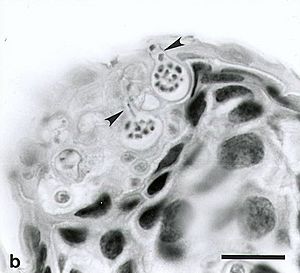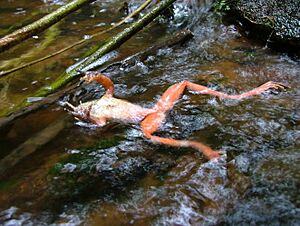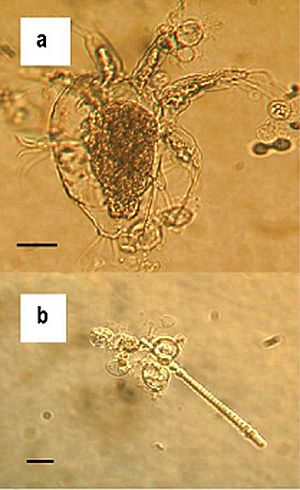Chytridiomycosis facts for kids
Chytridiomycosis is a serious disease that affects amphibians, like frogs, toads, and salamanders. It's caused by a tiny fungus called Batrachochytrium dendrobatidis, often shortened to Bd. This disease is a major reason why amphibian populations around the world are shrinking. It has even caused some species to disappear completely. The fungus can kill many amphibians, and there isn't a simple cure. It's believed to have reduced amphibian numbers by 30% globally.
Contents
How the Chytrid Fungus Spread
The chytrid disease was first officially found in 1993. Scientists discovered it in sick and dying frogs in Queensland, Australia. However, it had likely been in Australia since at least 1978. Today, this fungus is found all over the world. You can find it in Africa, North and South America, Europe, New Zealand, and other parts of Oceania.
In Australia, the fungus has been found in several areas, including the east coast and Western Australia. It's probably in even more places. Some scientists think that African clawed frogs helped spread the fungus. These frogs were traded internationally for over 60 years. If the fungus started in Africa, these frogs might have carried it to other continents. The earliest known case of chytridiomycosis was in an American bullfrog collected in 1978. Scientists are still trying to figure out if this fungus is new or if it's an old fungus that has recently become much more dangerous.
Signs of Chytrid Infection

Amphibians infected with the Bd fungus show several signs that they are sick. One of the first signs can be that they stop eating. This can happen as early as 8 days after they get infected. Infected amphibians also often become very slow and tired. They might not move even when you try to get them to.
Many frog species with Bd infection start shedding their skin a lot. The shed skin often looks cloudy, gray-white, or tan. Sometimes, these pieces of skin stick to the amphibian's body. These signs usually appear about 12 to 15 days after exposure to the fungus. The most common and serious symptom is that the amphibian's skin gets very thick. This is a big problem because amphibians use their skin to breathe, absorb water, and get rid of toxins. When their skin thickens, they can't do these important things, which quickly leads to their death.
How Amphibians Fight Back
Because this fungus has such a huge impact on amphibians, a lot of research is being done. Scientists are trying to find ways to stop the fungus from spreading in nature.
One area of study is the tiny living things on an amphibian's skin. These include good bacteria that can help protect the amphibian. Understanding how these skin microbes interact with the fungus can explain why some amphibians, like the mountain yellow-legged frog, get very sick and die. It also helps explain why others, like the four-toed salamander, can live with the fungus without getting seriously ill.
One interesting study suggested that a tiny water flea called Daphnia magna might help. It seems that these water fleas eat the spores of the chytrid fungus, which could help reduce the amount of fungus in the water.
Treating Chytrid Infections
Scientists have looked into different ways to treat amphibians infected with the Bd fungus. Some treatments include using antifungal medicines or warming up the amphibians. However, some antifungal medicines can cause bad skin reactions in certain frog species. Even with treatment, the infection might not completely go away.
This creates a difficult situation. Without treatment, frogs can suffer from body problems and even die. But with treatment, they might have skin issues. Also, treatment doesn't always work, and some frogs are too weak to handle the treatment process. It's very important to talk to a veterinarian before trying to treat frogs with chytridiomycosis.
In one case, an Archey's frog was successfully cured of chytridiomycosis. This was done by putting a medicine called chloramphenicol on its skin. However, using strong antifungal medicines on individual animals can have high risks.
See also
 In Spanish: Quitridiomicosis para niños
In Spanish: Quitridiomicosis para niños



